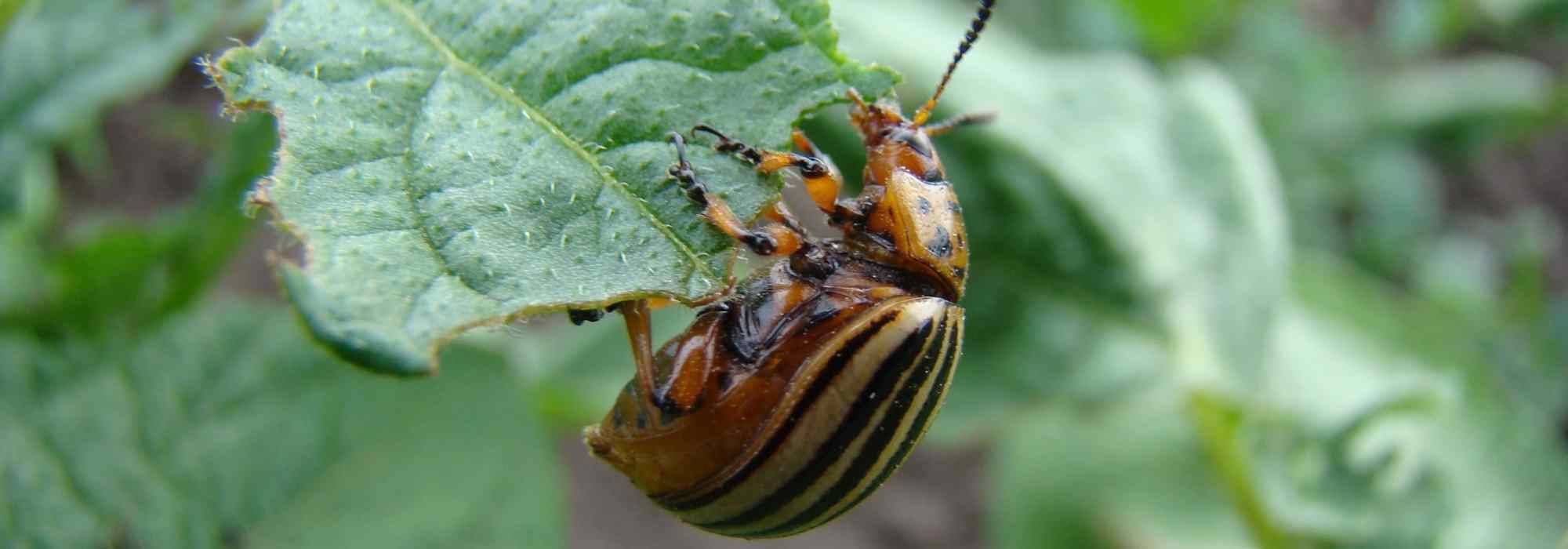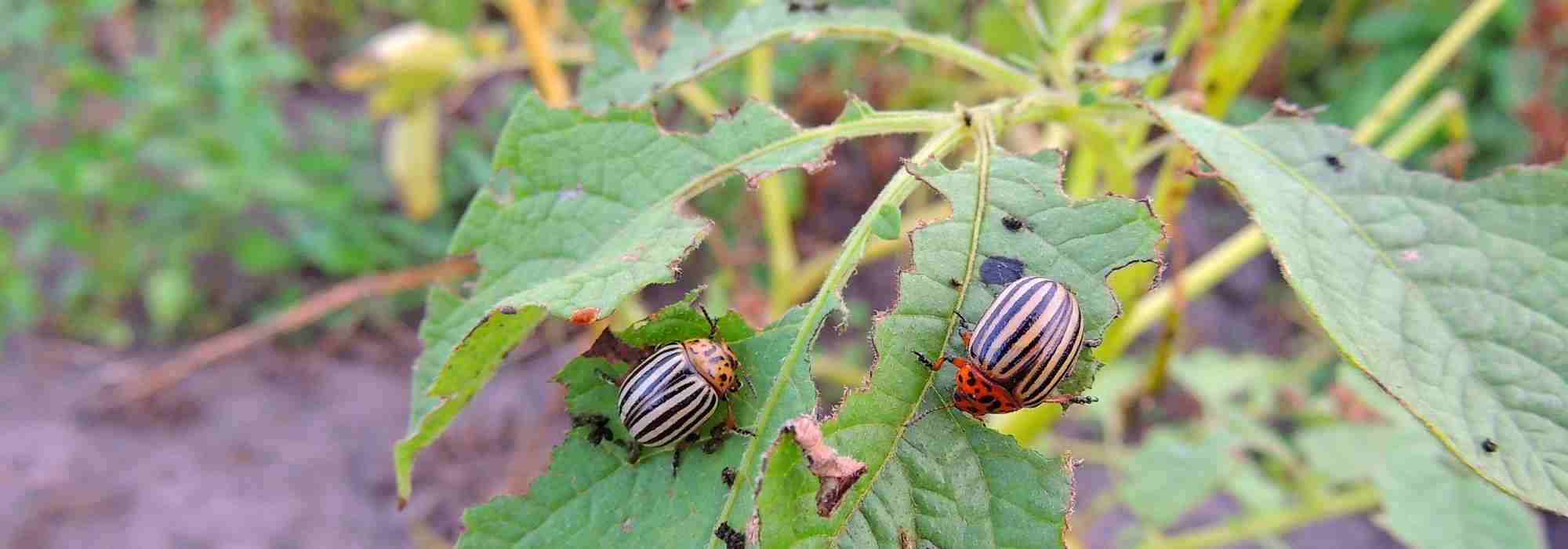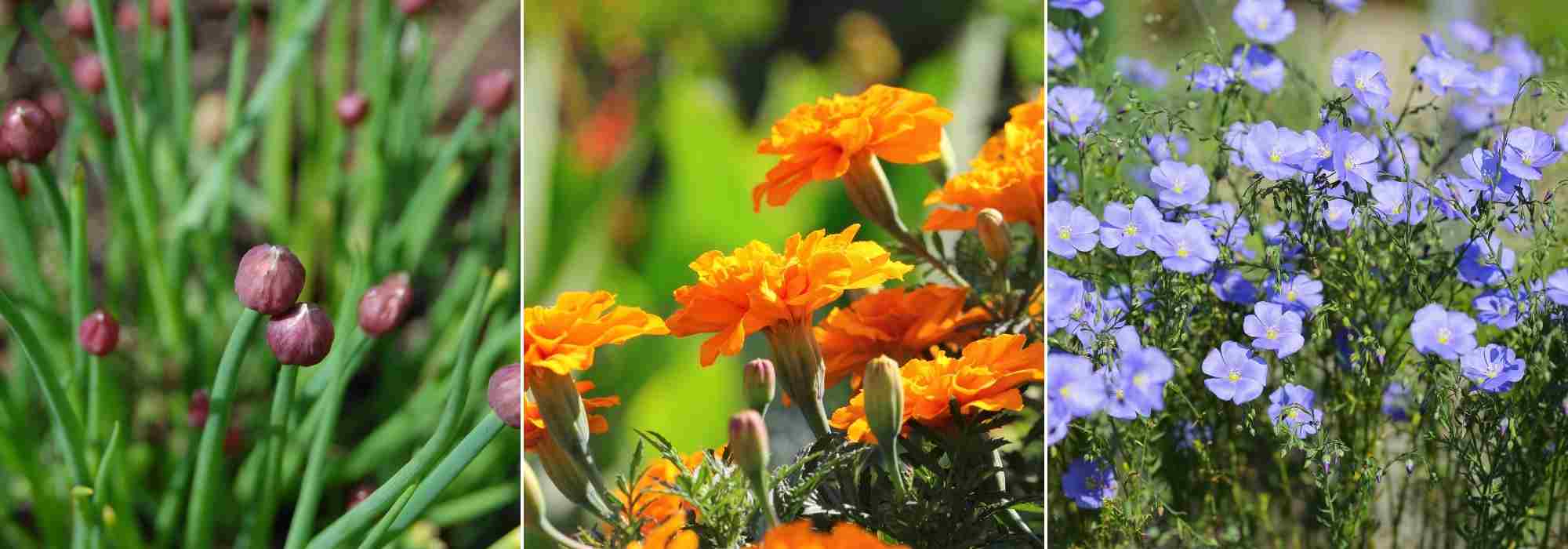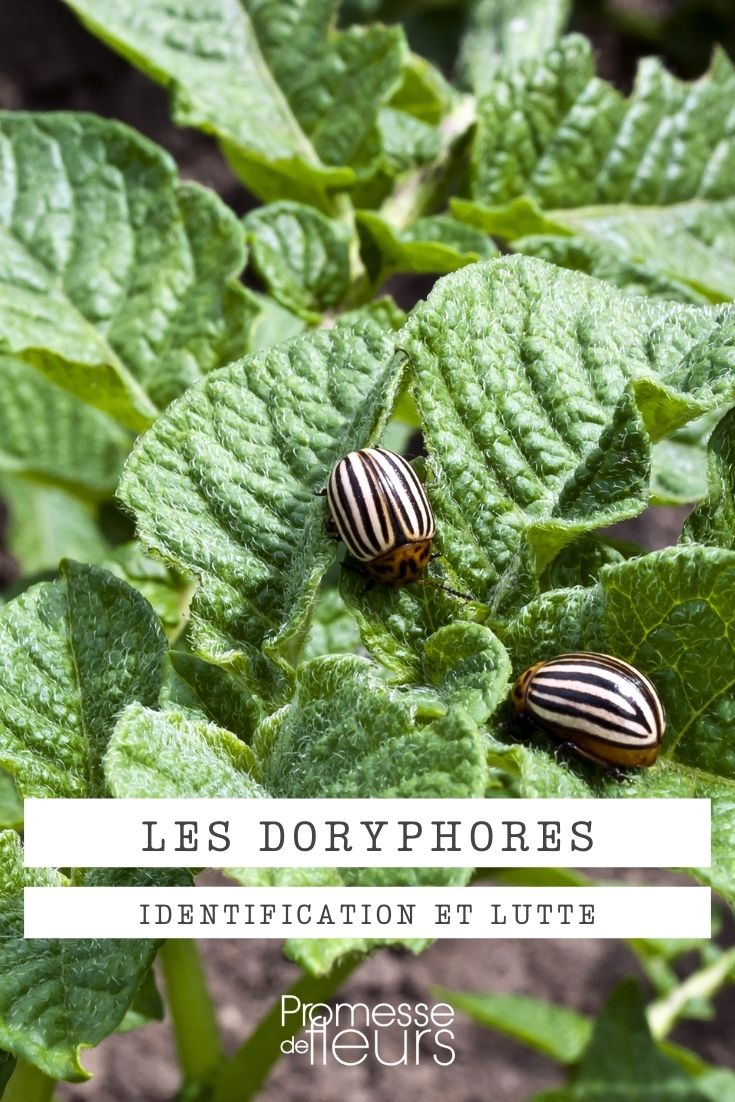
Colorado potato beetle: identification, damage and natural treatment
Potato enemy
Contents
Like many small garden pests, Colorado potato beetles initially seem rather harmless. This small, round and colourful insect devours the leaves and roots of potato, but also other solanaceous plants, such as aubergine.
Its rapid reproduction makes it one of the garden’s most feared insects.
So how to protect young plants from this unwelcome pest? Let’s review preventive measures and natural solutions usable in the organic vegetable garden: planting repellent flowers to deter Colorado potato beetles, manual harvest or introduction of nematodes.
How to identify the Colorado potato beetle?
Recognising adult Colorado potato beetle and its larva
Colorado potato beetle (Leptinotarsa decemlineata) is a small beetle about 1 cm long from North America, which colonised Europe during potato imports in the 1920s.
Its domed, shell-like body bears distinctive yellow and black stripes. In nature, these colour patterns serve as warning signals, helping it avoid natural insect predators such as birds.
Under its elytra are wings that allow it to fly, enabling it to travel tens of kilometres in search of host plants.
Colorado potato beetle larva shares the same colour code as the adult: it is red with black spots on the sides, dome-shaped. Its head and legs are entirely black.

Adult Colorado potato beetle, and its larva on the right
Life cycle of the Colorado potato beetle
Robust, adult Colorado potato beetle tolerates cold well, which helped its rapid colonisation of Europe.
It spends winter in dormancy in soil, emerging from the ground at the start of spring for its first meal, from April.
Female lays small yellow eggs on undersides of host plant leaves from spring until the end of summer. Over its lifetime, it may lay up to 2,500.
After a short incubation of 4 to 10 days, Colorado potato beetle larvae hatch and begin devouring the surrounding leaves.
They then transform into pupae which, after burying themselves in soil for around fifteen days, become adult Colorado potato beetles. They then feed on roots and tubercles before returning to plant foliage.
At the end of summer, adults enter diapause again and begin a new cycle. Lifespan is 1 to 2 years.

Damage caused by the Colorado potato beetle to crops: symptoms and consequences
It is its ability to reproduce rapidly and in large numbers that makes the Colorado potato beetle an insect capable of becoming highly problematic in the garden.
Both the larva and the adult can cause significant damage to solanaceous plants: mainly potatoes, but also aubergines and tomatoes.
The period of activity of the Colorado potato beetle runs from spring to summer, from April to September.
The Colorado potato beetle devours leaves as well as stems, roots or tubercules. Foliage then becomes riddled with holes, as with a caterpillar attack (pierids, noctuids…), but the adults, with their conspicuous colouring, are easy to spot and allow the diagnosis to be confirmed.
In the long term, foliage may disappear and lead to the destruction of a crop by weakening the young plant and slowing growth.
This also affects the harvest by reducing the size of the tubercules, a favourite food of young adult Colorado potato beetles.

Natural treatments to get rid of Colorado potato beetles
Once presence of Colorado potato beetle is confirmed, you can still act to limit its development and impact on crops.
Manual harvesting
At start of infestation, you can opt for manual harvest of Colorado potato beetle larvae and adults: monitor susceptible young plants regularly and remove individuals as you find them.
Eggs may also be spotted on undersides of leaves and destroyed.
This method can prove time-consuming and meticulous depending on size of cultivated plot, but it is most effective and has advantage of having no negative impact on environment.
Introducing a natural predator of Colorado potato beetle
Biocontrol is a plant protection principle that reproduces natural mechanisms which balance plants and pests. It therefore excludes use of chemicals.
Use of beneficial insects is permitted in organic agriculture to combat Colorado potato beetles: nematodes, microscopic worms, parasitise and kill Colorado potato beetle larvae, but also other pests (moths, crane flies…).
The species Steinernema carpocapsae is a worm naturally present in European soils and resistant to cold. This microorganism does not impact beneficial insects and does not present proven risk to humans or animals.
Nematodes will be applied by spraying on infested vegetation, as soon as larvae appear on foliage (so this is not a preventative treatment). After application, they will search in soil or on young plants for Colorado potato beetle larvae, which will then be parasitised and eliminated within 24 to 48 hours.
Promoting biodiversity and presence of predators of pest insects can also help balance presence of Colorado potato beetles naturally. Carnivorous green grasshopper, for example, feeds on both caterpillars and Colorado potato beetle larvae.
Finally, chickens, great allies of gardeners, will happily scratch soil at end of winter to eliminate undesirables in dormancy.
Natural products
Beyond significant impact of chemical treatments on environment and living organisms, Colorado potato beetles seem to have developed resistance to chemicals over time.
There are however natural repellent products:
- sprays of manures (nettle, tansy, comfrey…), prepared by letting leaves macerate for a few days in water
- organic insecticidal products based on pyrethrum
- Bordeaux mixture (copper sulfate)
These products are however not selective, which is why their use is recommended only occasionally. They affect pests as much as beneficials, such as pollinating insects. An evening spray will be less harmful for small pollinators.
Prevention measures against Colorado potato beetles
Practice crop rotation
As often for disease and pest prevention, crop rotation plays an important role: avoiding growing plants from the same family on the same plot for several consecutive years helps limit presence of Colorado potato beetles.
Remove spontaneous regrowth as it appears: adult beetles potentially in dormancy in the soil will then find no food on site when they emerge.
Grow early varieties, whose premature dieback of foliage will also remove a food source for Colorado potato beetles.
Use repellent flowers and opt for companion planting
Pairing potatoes and other host plants of the Colorado potato beetle with repellent plants shows good results.
Garlic, chives, hemp and castor have repellent properties against pest insects.
Establishing a fallow area sown with a mix of easy-to-grow annual flowers limits presence of Colorado potato beetles by making environment less hospitable: plant blue flax, annual savoury and French marigold near target vegetables, between the ranks or at edges. The aromatic compounds they release are known to deter Colorado potato beetles.
Flowering will occur from June to September, during the Colorado potato beetle’s period of activity. This solution has the advantage of combining aesthetics with prevention.

Among companion plants: chives, marigolds and flax
- Subscribe!
- Contents
































Comments